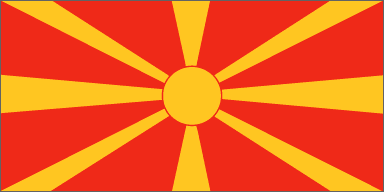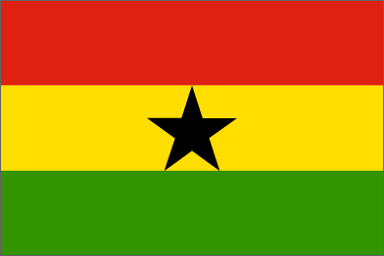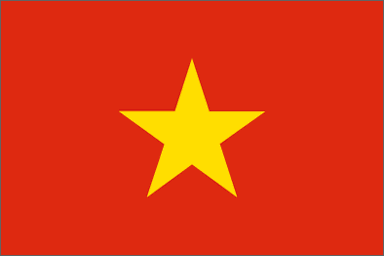|
Brief History of Color
and Symbolism in National Flags By
Aaron Larrimore
Flags are an important symbol, if not the most important
symbol, of a nation’s identity. For the citizens of a state,the flag
is instantly recognizable and it represents the binds that hold society
together. Of course, the flag serves a representative purpose of the
ideals and identity of the state and does not specifically promote them,
nor are those ideals and identities represented only in the flag.
Nevertheless, a state’s national flag is a powerful symbol.
The flags chosen for the paper were chosen randomly.
In order that they were not skewed towards one region or continent at
the expense of others, the randomly chosen flags were taken from each
continent. These continents include North America, South America, Europe,
Asia and Africa. Australia was omitted because only Australia and New
Zealand can be grouped in the region as "Australian" states
and because the countries are primarily made up of European immigrants,
and therefore do not represent an indigenous difference from flags found
in Europe and to a lesser extent, North and South America. Antarctica
was omitted because there are no countries located on the continent.
The five flags discussed are the Colombian flag (South
America), the Haitian flag (North America), the Macedonian
flag (Europe), the Ghanaian flag (Africa) and the Vietnamese
flag (Asia).
The flag of Colombia is one half yellow, one
quarter blue and one quarter red. There are two interpretations
on the meaning of the flag. The first states that yellow stands
for sovereignty and justice, the blue stands for nobility,
loyalty and vigilance and the red stands for valor, honor,
generosity and victory. The second interpretation states that
yellow stands for universal liberty, the blue stands for equality
and the red stands for fraternity. It is distinct from the
Spanish flag, which would have been prevalent before independence
The history of the Colombian flag dates back
to the country’s independence in 1819, though the present
flag would not be adopted until 1861.
The flag is expected to be flown on national holidays by private
citizens.
The Flag of Colombia

|
The flag of Haiti has changed frequently since
the country reached independence in 1801. A common element
in all the flags has been "mimicry" of the French
flag. France had been the colonial power that ruled over Haiti
pre-independence. French culture has remained a powerful force
in Haiti and the French language remains the lingua franca
of the island. The present flag is one part dark blue and
one part red. The French tricolor has white as well. The tricolor
features the colors in equal bars running vertically. The
Haitian flag’s two colors are placed horizontally.
The Flag of Haiti

|
The creation of the contemporary Macedonian
flag dates back to 1992, after the country gained independence
from Yugoslavia. The flag is very distinctive, featuring a
red background and a yellow sun and rays in the foreground.
This is rooted in Macedonian history and previous flags before
the union with Yugoslavia and the adoption of communism.
The flag dates back to the legendary Macedonian
figure of Phillip II and his dynasty (his son was Alexander
the Great) and his called today the Vergina dynasty. The sun
was the ancient symbol of the royal house. The flag clearly
serves as a unifying national symbol in this case, as it hearkens
back to history and nationalism.
The Flag of Macedonia

|
The flag of Ghana presents a strong statement
of political unity and in contrast to Haiti, a break with
its colonial past. The colors of the flag are red, yellow
and green and each are one third of the flag, laid out horizontally.
The three colors are the colors of pan-African unity. In the
period after WWII, the pan-African movement was a political
force that in its mainstream form did not endorse a mega-state
of African states, but instead advocated strong political,
economic and cultural ties between the new African states.
Ghana was the first African state to be decolonized
and its first leader, Nkrumah, was determined to make Ghana
a leader in the emerging African political scene. Nkrumah
wanted Africa and the world to view Ghana as the beacon of
African independence and unity. This drive is reflected in
the flag of Ghana, which not only has uses the pan-African
colors, but also features a prominent black star in the middle.
The black star represents the fact that Ghana was the first
African country to receive independence.
The Flag of Ghana

|
The Vietnamese flag is also overtly political,
perhaps more so, than the flag of Ghana. It features a deep
red color that encompasses the entire flag with a single yellow
star in the middle. The colors and the star are reminiscent
of other communist states, including the Soviet Union and
China. The use of the red/yellow combination belies the intense
identification with the state and nation with communist ideology.
Whereas other communist states in Eastern Europe used symbols
like the star in their flags, the deep red color was often
absent, replaced by colors used in the flags of the nation
in years past. For many nations that experimented with communism,
the national colors remained the same. The flag as
a representation of the country remained the preserve of national
and or ethnic identities.
The Vietnamese flag represents a break with
the conception of national identity and instead promotes an
ideological identity rooted in the beliefs of communism. Given
that Vietnam had been a French colony prior to its independence,
there was no "prior" flag to work with. All the
same, the Vietnamese flag shows that flags can also represent
ideology as opposed to less mutable ideas as nationhood or
ethnic identity.
The Flag of Vietnam

|
National flags serve one overriding purpose, the symbol
of national unity.
This can veer from the ideological binds of the state in the case of
Vietnam, ancestral ethnic binds in the case of Macedonia, or a combination
of the two, as in the case of Ghana.
Flags can be influenced by other nations in the case of Haiti, or they
can differ greatly from previous cultural milieus in the case of Colombia.
Works Consulted:
Birmingham, David. Kwame Nkrumah. Athens : Ohio
University Press, 1998.
Brown, Keith, The Past In Question. Princeton, N.J. ; Oxford
: Princeton University Press, 2003.
CIA World Factbook: http://www.cia.gov/cia/publications/factbook/
Colombia: http://www.colostate.edu/Orgs/LASO/Colombia/colombia.html
http://www.1uptravel.com/flags/largeflags/colombia.html
Harding, Colin. Colombia . London : Latin America Bureau ; New
York : distributed in North America by Monthly Review Press, 1996.
Ghana: http://www.ghana.gov.gh/index.php
http://www.1uptravel.com/flags/largeflags/ghana.html
Haiti: http://www.haiti.org/
http://www.1uptravel.com/flags/largeflags/haiti.html
Macedonia: http://www.macedonia.org/
http://www.1uptravel.com/flags/largeflags/macedonia.html
Vietnam: http://flagspot.net/flags/vn.html
http://www.1uptravel.com/flags/largeflags/vietnam.html
|




